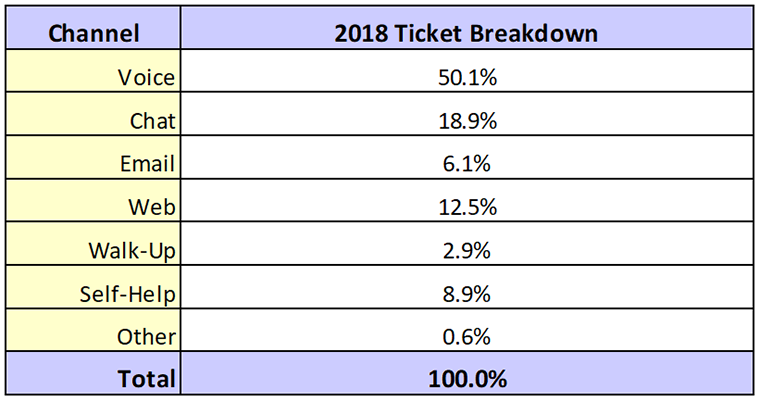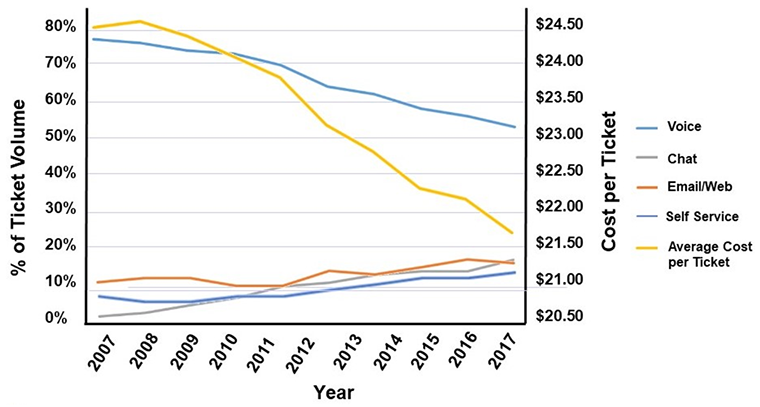Date Published January 24, 2019 - Last Updated December 17, 2019
Each month, I highlight one Key Performance Indicator (KPI) for service and support. I define the KPI, provide recent benchmarking data for the metric, and discuss key correlations and cause-and-effect relationships for the metric. The purpose of the column is to familiarize you with the KPIs that really matter to your organization and to provide you with actionable insight on how to leverage these KPIs to improve your performance! This month, I look at channel mix.
Channel mix is the percentage of incoming tickets that arrive at the service desk through various channels. The most common channels include walk-up, voice, email, web, chat, and self-help. Across North America in 2018, the incoming channel mix breaks down as follows:

Why It’s Important
Channel mix at level 1 is rapidly evolving (illustrated in the figure below), and is considered one of the industry’s megatrends. In 2007 voice calls represented almost 80% of all ticket volume. Today, voice accounts for just over 50% of incoming ticket volume.
There are two key drivers behind this trend. One is economic, and the second is demographic. The key economic driver is that voice, which has dominated the industry for decades, is one of the most expensive channels, while chat, email, web, and especially self-help (discussed in a previous Metric of the Month) are all lower cost than voice.

Self-help tickets are lower cost than voice for obvious reasons. But it’s not so obvious why chat, email, and web submitted tickets are lower cost than voice. Since voice is a real-time channel, the Erlang distribution of incoming calls tends to be very spiky. This, in turn, makes it challenging to staff the voice channel efficiently. The voice channel is perpetually either understaffed or over-staffed! Chat is also a real-time channel, but an effective chat agent can often handle two or more concurrent sessions, thereby making chat more efficient than voice. In fact, MetricNet’s benchmarking data shows that the average ticket resolved in chat costs just 76% as much as a ticket resolved in the voice channel.
Email and web submitted tickets tend to be lower cost than voice because these channels do not have quite the same real-time urgency as voice, and they are therefore less spiky than voice and chat. This makes it easier to staff the email and web channels, which leads to better agent utilization and lower costs. On average, the cost of an email or web-submitted ticket is about 81% of the cost of a voice resolved ticket.
What about the demographic drivers behind channel mix? If you look at a spectrum of IT users—from those who are newest to the workforce, to those nearing retirement—younger users tend to prefer self-help or the indirect channels of chat and email, while those who have been in the workforce for some time lean much more heavily on live voice as their go-to channel for support. This trend, of course, will continue, as newer workers continue to enter the workforce.
Optimizing Channel Mix
What is the right channel mix, and how does a service desk achieve that state? The answer depends upon the unique nature of the support environment that you operate in. It would be tempting to suggest that the ultimate channel mix is to drive all contacts into self-help, thereby eliminating all costs associated with voice, chat, email, and web support. But this is neither realistic nor wise. There are many incidents that simply cannot be resolved in self-help. Moreover, as discussed in past articles, a user that spends more than 10 minutes at a time in the self-help portal is likely to be costing the enterprise more in lost productivity than it is saving in direct support costs.
What is the right channel mix, and how does a service desk achieve that state?

There are, however, better end states for channel mix, and less optimal end states for channel mix. The service desks that come closest to truly optimizing their incoming channel mix are guided by the following principles. First, they ensure that users have a great experience regardless of which channel they choose. Offering chat might sound good, but a poorly implemented chat channel can have an adverse effect on both the user and the reputation of the service desk. Secondly, they never force a user into a particular channel. Rather, they give them incentives to use lower cost channels. Some examples come to mind here.
Every voice or chat session should be viewed as an opportunity to educate the user. If you simply return a user to service without providing a re-usable solution, they will contact support again and again with the same issue. This is akin to the “give them a fish vs. teach them how to fish” allegory. If you can teach a user how to quickly resolve some of their own incidents, you can reduce incident volume at the service desk while simultaneously empowering the user. This could be as simple as pushing a knowledge article to the user or walking the user through a co-browsing troubleshooting session.
A second common practice is to play a wait time message when the voice channel is experiencing heavy volumes. Sharing simple information such as the expected wait time and a URL for chat, email, or self-help support can encourage trials and ultimately adoption of a new (lower cost) channel by the user.
Finally, they minimize costs, consistent with principles one and two. In other words, they are proactive about driving contacts into lower cost channels, but they never override the will of the user or sacrifice the user experience in doing so.
Join Jeff for a metrics deep dive pre-conference workshop at HDI 2019
Join us!
Key Takeaways
Channel mix will continue to evolve for many years to come. Voice is decreasing as a percent of all incoming tickets, while chat, web, email and self-help are all on the rise. There are both economic and customer experience benefits to be had by proactively managing this evolution. Users can and should be encouraged to use lower cost channels, but never at the expense of the user experience.
Please join me for next month’s Metric of the Month: Agent to Supervisor Ratio, a span of control metric that has implications for agent coaching, training, and job satisfaction.
Jeff Rumburg is the winner of the 2014 Ron Muns Lifetime Achievement Award, and was named to HDI’s Top 25 Thought Leaders list for 2016. As co-founder and CEO of MetricNet, Jeff has been retained as an IT service and support expert by some of the world’s largest corporations, including American Express, Hewlett Packard, Coca-Cola, and Sony. He was formerly CEO of the Verity Group and Vice President of Gartner. Jeff received his MBA from Harvard University and his MS in Operations Research from Stanford University. Contact Jeff at
[email protected]
. Follow MetricNet on Twitter @MetricNet.